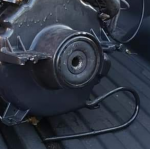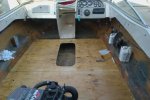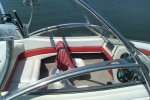I/O boats like mine require a blower to draw gas fumes out of the bilge. They say to run it for 4 minutes before starting the engine. I decided to install two of them instead.
My hull is not designed like factory. My boat will draft air from under the deck, down to the ski locker, around the fuel tank and then into the bilge. Fresh air will come in through the raceways that I just built along the sides. It will move a huge volume of air in a very short period of time. I've been reading the USCG requirements and doing the math. I'm an engineer; that's how I operate. LOL
I also wired the bilge pump and set it in place. The installation isn't quite finished though.
I had to flip my switches around, and replace one with a different type. Almost ready to attach the dash...
But first, I need to make new piping for the edge to give it a finished look. For that, I used upholstery vinyl around foam. (Backer Rod) I neeeded something larger and more compliant than upholstery piping, and the backer rod was nearly perfect.
This is the first time using this new machine. Liking it so far. It's an affordable compromise that I feel will suit my diverse needs in a sewing machine. I couldn't justify a dedicated upholstery machine. This does have a walking foot attachment, however.That should be a huge help.
With the dash complete, (Stereo will be a future project) I finished buffing the white gelcoat in that area, and then screwed the panel in place. Turn the page...
The next chapter will be seat restoration.
I'm lucky to have as much as I do because this stuff is expensive. I had to buy used pedestals and a new plastic pivot bushing. But new seats start at $250.00 each, and the Springfield slider assemblies are pricey as well.
Doing it this way will only require some vinyl and foam. Plus, I can get creative with the look!
The existing vinyl is so brittle that I cannot use it for patterns. The wood is long gone. The foam is too hasty to reuse. The roto-molded frames are good, though. LOL


































































